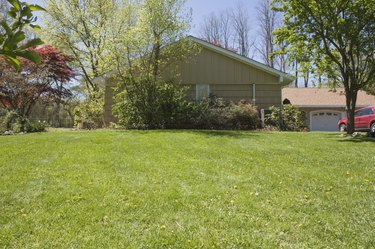Things You'll Need
General grass killer
Dirt
Soil pH test kit
Lime
Grass seed

Nimbleweed, or nimblewill, has a tendency to overtake a lush, grassy yard with its thin, spindly leaves. A perennial grass, it emerges every spring like clockwork. Because of nimbleweed's similarity to traditional grass, it survives treatment from typical herbicides and pre-emergent weed killers. Effectively killing nimbleweed calls for the application of a general grass killer, which will destroy desired grass as well, requiring its replanting. Consider addressing the features of your lawn that encourage nimbleweed growth before replanting grass seed to reduce its recurrence.
Step 1
Identify the sections of your lawn where nimbleweed is growing. Spray a general grass killer on the nimbleweed itself and 10 to 12 inches beyond it to ensure complete eradication. Wait the recommended time for your particular grass killer to take effect, killing the grass and nimbleweed.
Video of the Day
Step 2
Check the nimbleweed area for excess water in the soil, an environment that encourages nimbleweed growth. Fill in any low areas with dirt to reduce water retention and avoid repeat nimbleweed growth.
Step 3
Test your soil with a soil pH test kit according to the instructions for your kit. If the test shows a low pH, mix lime with your soil to raise the pH and provide an inhospitable environment for nimbleweed.
Step 4
Place new grass seed in the location of the dead grass and water it well. Keep the soil moist until the grass begins to sprout. Water it regularly to allow the grass to fill in completely.
Tip
Kill nimbleweed during the late summer, if you live in a cold-winter climate, so the new grass has time to grow before winter.
Warning
Use caution when handling grass killer because it is toxic to humans and animals.
Video of the Day